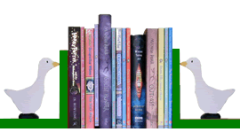![]() What’s up with Ella? Medikidz explain Type1 Diabetes
What’s up with Ella? Medikidz explain Type1 Diabetes
![]() What’s up with Max? Medikidz explain Asthma
What’s up with Max? Medikidz explain Asthma
by Dr Kim Chilman-Blair and John Taddeo
(Medikidz)
These two titles are both from a series of books that use graphic novel format and a set of superhero characters to explain medical conditions to young people. In each one, the superheroes take a teenager with that condition on a trip to Mediland – a planet shaped like a human body where factories stand in for insulin producing cells and space troopers do the work of the immune system. While they’re there, the youngsters see how their body works, what their problem is and what they can do to cope with it.
It’s often difficult to persuade youngsters with health issues to read books and pamphlets designed to help them. Hopefully the graphic novel approach used in this series will help overcome some of that resistance.
Other conditions covered include epilepsy, HIV, ADHD and leukaemia.
Buy Medikidz explain Type 1 Diabetes from Amazon
Buy Medikidz explain Asthma from Amazon
![]() Freaks, Geeks & Asperger Syndrome: A User Guide to Adolescence
Freaks, Geeks & Asperger Syndrome: A User Guide to Adolescence
by Luke Jackson
(Jessica Kingsley Publishers)
Luke Jackson, the thirteen year old author of this book writes with maturity and insight showing the reader clearly what it is like to have Asperger Syndrome. The descriptions of his family members are delightful and honest (though there is no mention of Dad). In each chapter Luke gives us something to think about, and his lists of rules and tips make so much sense. The chapter on bullying is particularly poignant and upsetting and would provide valuable resource materials for student teachers especially those wanting to teach physical education.
A personal account, such as this about ‘being Aspergers’, makes understanding the particular syndrome so much clearer and needs to go hand in hand with all the theory. So, I hope this highly readable book reaches not only its intended audience, other teenagers with the syndrome, but also all professionals working with children and young adults who have Asperger Syndrome.
(reviewed by Pat Winson)
Buy from Amazon
![]() Wha’ever: The teenager’s guide to spinal cord injury
Wha’ever: The teenager’s guide to spinal cord injury
by Meg Harper
(Spinal Injuries Association)
As the title suggests, this book is aimed at teenagers who have recently had a spinal cord injury. Presented in ring binder format, it uses bright colours, colour photos and magazine style layout to grab the reader’s attention. Taking a positive approach without ignoring the downsides of disability, Meg Harper has used check lists, diary extracts and quotes from other teenagers to make the book highly readable and great to dip into. The whole emphasis is on gaining and keeping independence and making the most of life, so the advice includes going back to school, going on holiday, going to college, coping with parents, friends and relationships, leaving home and learning to drive. This well planned and accessible guide should be a great help for teenagers with spinal injuries and for their friends and family. It could also help young people who have begun to use a wheelchair for other reasons.
Available from the Spinal Injuries Association
